Judi Lynn
Judi Lynn's JournalWho Made Peru's Wari Pottery?
Friday, March 17, 2023

Peru Wari Vessel(Courtesy Cerro Baúl Archaeological Project/Photo by P. R. Williams, Catalog number CB-V001)
CHICAGO, ILLINOIS—According to a statement released by the Field Museum, researchers led by M. Elizabeth Grávalos and Patrick Ryan Williams analyzed the chemical makeup of ceramics unearthed at different sites in the Wari Empire, which covered more than 1,000 miles over the Andes Mountains and the coast of Peru from A.D. 600 to 1000. The scientists wanted to determine if areas colonized by the Wari Empire imported ceramics from the Wari capital, or if the local potters continued to produce their own wares. The results of the study suggest that in some areas of the empire, Wari colonists had their own production centers and recreated traditional Wari-style pottery in new locations. In other areas, local potters made Wari-style pottery in their own way, blending Wari style with local traditions. “Local production, even in a cosmopolitan society with lots of far-flung connections, makes a society more resilient,” Williams said. “If you’re entirely dependent on someone far away sending you things you need, you’re extremely vulnerable,” he concluded.
https://www.archaeology.org/news/11291-230317-peru-wari-pottery
~ ~ ~
15 March 2023 / Matthew Agius
Forget the Inca, this was Peru’s first major empire, and thanks to ancient pottery we know how powerful it was
Paint It, Black.
Ancient pottery has revealed the reach of the Wari empire, which was prominent in modern-day Peru between the seventh and eleventh centuries.
The groups that existed amid this empire used a material rather than written culture, so their art and objects provide archaeologists with the best glimpse into their unique history.
Now new research from several collaborating US institutions has shed light on the reach of the Wari through an unusual material: pigment.
“People sometimes think of the Inca as the first big empire in South America, but the Wari came first,” explains Luis Muro Ynoñán from the Field Museum of Natural History in Chicago.
“Since they didn’t use writing… things like pottery would have been an important means for conveying social and political messages. The visual impact of these objects would have been super powerful.”
More:
https://cosmosmagazine.com/history/ancient-peruvian-empire-pottery-pigment/
~ ~ ~
Bowl, Mythic Figures
Wari
6th–9th century
![]()
During the second half of the first millennium A.D., the Wari peoples, centered in the Ayacucho region, dominated the south-central Andes. They interacted with contemporary peoples in far-flung areas such as the powerful city of Tiwanaku in present-day Bolivia and the peoples of the Nazca region on the southern coast of Peru. The nature of Wari's relationship with these and other peoples is still unclear, but their influence on Wari art is undisputed. While the shape of this vessel and the painting style—vivid slip paints of red, purple, yellow, gray, and white and the use of thick black outline—follows a long-standing southern coast tradition, its religious imagery is found on major stone monuments at Tiwanaku. The outer surface of the straight-sided bowl is divided into four panels; two are decorated with the square face of an abstract supernatural. It has a rayed headdress resembling Tiwanaku's principal deity. The fangs and split white and black eyes are characteristic Wari features. The two other panels show the profile bird head with a prominent curved beak; the heads are framed by a U-shape from which alternating bird heads and stylized plants, perhaps corn, emanate.
https://www.metmuseum.org/art/collection/search/312607
~ ~ ~
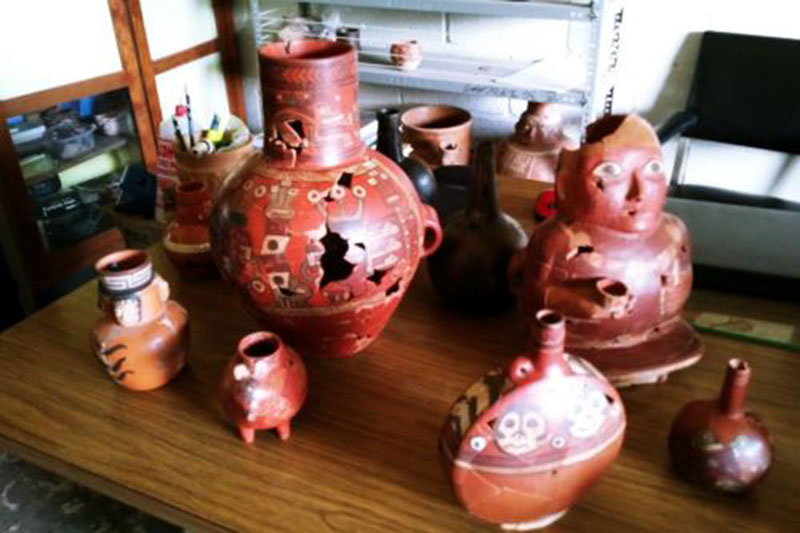
Study of Wari civilization ceramics in Peru reveal its origins
Dozens of restored ceramics link it to Nazca and Huarpa24 May 2019by Archaeology Newsroom A A A
The Wari archaeological complex in Ayacucho has yielded several ceramic pieces which offer an insight into the civilization’s origin. The site is located 25 km northeast of the Ayacucho City in the Andes.
Lead researcher at Wari complex Jose Ochatoma, an archaeologist at San Cristobal de Huamanga University, said 45 ceramics have been restored and studied. Research has shown that the origin of Wari is linked to the Nazca and Huarpa cultures. As is indicated by the figures the ceramics bear, namely representations of coastal animals and sea creatures, are similar to those in the iconography of the Nazca culture.
Thus researchers believe that the Wari were not influenced by Nazca and Tiahuanaco cultures, as it has been thought. They were first influenced by the Nazca culture and then the Tiahuanaco.
Restoring the ceramics has not been an easy task. The Wari used them in rituals where they were deliberately destroyed, so archaeologists could not always restore them to their original state. The stones used to break the ceramics have been also found.
The process of restoring the ceramics takes great time and effort but the results have so far been rewarding for researchers.
More:
https://www.archaeology.wiki/blog/2019/05/24/study-of-wari-civilization-ceramics-in-peru-reveal-its-origins/
~ ~ ~
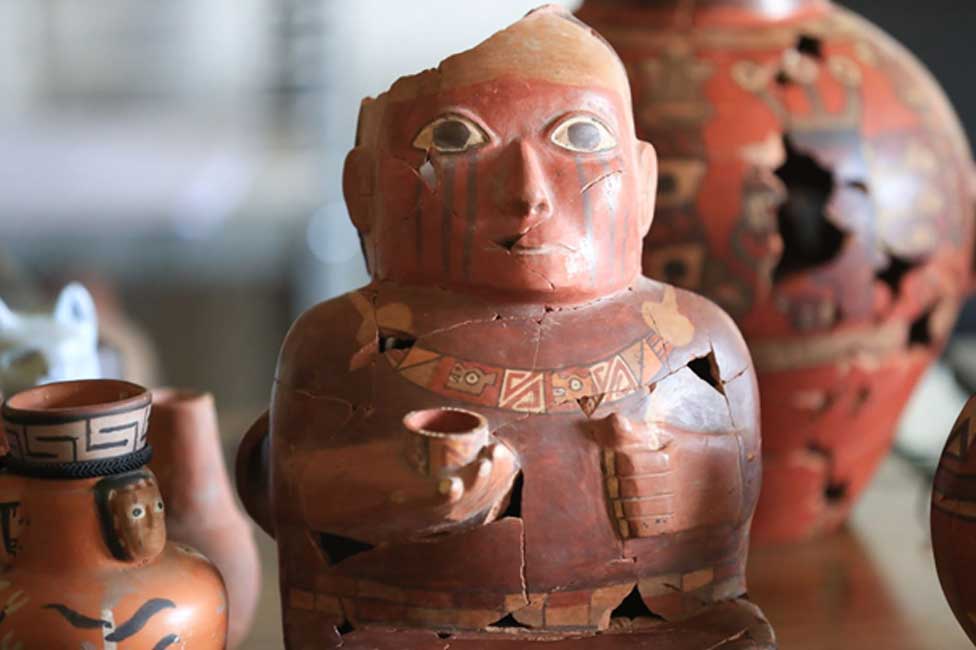
UPDATED 22 MAY, 2019 - 13:57 ED WHELAN
Study of Ceramics Provides New Thinking on Origins of First Peruvian Empire
The Andean nation of Peru has been the home of many important pre-Columbian societies. But their origins and development still holds many questions. Now a number of ceramic pieces are throwing light onto the first pre-Columbian cultures in the area, one which laid the foundation for future empires, such as the Wari and the Inca. The ceramics are providing unprecedented insights into the evolution of the Wari Empire and have revealed the importance of the earlier Huarpa culture in its development.
The stylized clay pottery was found at a site, called Wari, in the Ayacucho Valley, in the highlands of Peru. The archaeological site is located some 16 miles (24km) northeast of the modern regional capital, also called Ayacucho. According to the Expreso, this site is considered to be ‘the capital of this complex and well-organized pre-Hispanic civilization (600 AD-1,200 AD)’.
The Wari Empire
The Wari were an agricultural people whose development of terrace agriculture , allowed them to become the first state in the region from 600 AD – 1200 AD, before the Inca. They established an informal empire over an area that covers much of modern Peru by establishing colonies and using ritual ceremonies to ensure the obedience of other cultures. The Wari culture collapsed after a period of drought and many of its sites appear to have been ritually destroyed by the inhabitants.
Some 45 pieces of pained clay pottery were unearthed at the site in the valley. Many had to be painstakingly pieced together because of the Wari practice of breaking ceramics. The ceramics found at the Wari complex were examined by archaeologists from the San Cristobal de Huamanga University. The decorative elements in the pottery ‘include representations of coastal animals and marine products (seaweed, fish, octopus)’, according to the Archaeology News Network . They come from a variety of stages in the development of the Wari.
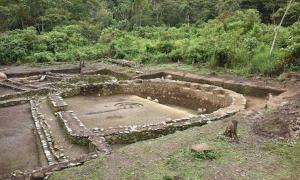
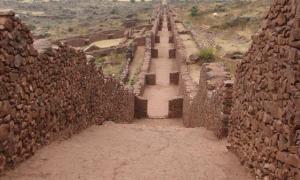
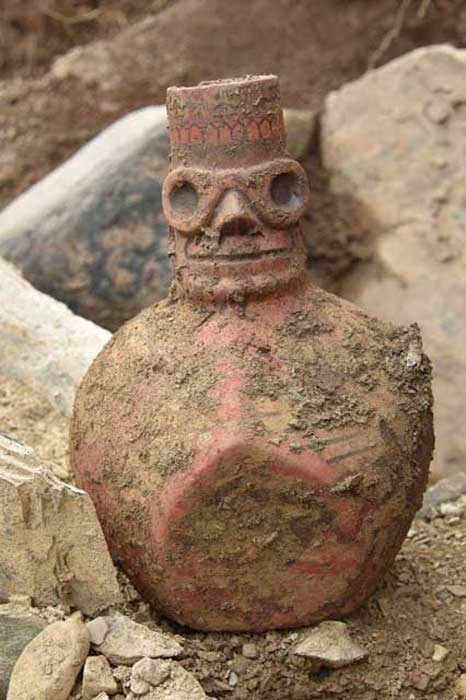
More:
https://www.ancient-origins.net/news-history-archaeology/wari-empire-0011942
HUMAN RIGHTS CLAIMS AGAINST CHIQUITA FOR FUNDING COLOMBIAN PARAMILITARIES WILL PROCEED IN U.S. COURT
HUMAN RIGHTS CLAIMS AGAINST CHIQUITA FOR FUNDING COLOMBIAN PARAMILITARIES WILL PROCEED IN U.S. COURT
Forum Non Conveniens Motion is Denied
. . .
In 2007, EarthRights International (ERI), joined by the co-counsel listed below, filed a class action suit against Chiquita on behalf of the families of thousands of villagers, labor leaders and community organizers murdered by the Autodefensas Unidas de Colombia (AUC), a notorious paramilitary terrorist organization. Chiquita made illegal, concealed payments to the AUC for years, totaling at least $1.6 million; the lawsuit also alleges that the AUC shipped arms and drugs through Chiquita’s ports and on Chiquita boats.
In March 2007, Chiquita pled guilty to the federal crime of funding a designated terrorist organization and paid a fine. “Chiquita profited from its relationship with the AUC, and paid the Department of Justice $25 million, but the victims of their conduct have received nothing – it is past time Chiquita compensates the families in Colombia,” said Marco Simons, ERI’s General Counsel. “We are pleased that the Court agreed that ‘The United States has a strong interest in monitoring and deterring unethical and illegal conduct of American corporations in supporting foreign terrorist organizations.’ The Plaintiffs sued Chiquita here in its home court where Chiquita will get a fair hearing on the merits, something the company seems to have been trying to delay for a decade,” added co-counsel Agnieszka Fryszman of Cohen Milstein Sellers & Toll.
Despite the fact that Chiquita pulled out of Colombia, and now has no operations or assets there, Chiquita argued that it was more “convenient” for them to litigate in Colombia than the United States. The court rejected this position, finding Colombia to be an inadequate forum in light of the serious security risks for Plaintiffs and their lawyers. Colombia is one of the most dangerous countries for human rights defenders where at least 335 were murdered between 2009 and 2015. “Our clients chose to litigate in the United States because it is the only forum where they can litigate safely and where they can be sure that Chiquita will pay,” said Simons.
The case against Chiquita will continue for its alleged violations of Colombian law. The Plaintiffs have also sued several former Chiquita executives that were allegedly responsible for making, approving and concealing the payments to the AUC. And, on June 1, 2016, Judge Marra ruled that the claims against those executives, including claims for torture and extrajudicial killing under the Torture Victim Protection Act, could also continue. The case now moves into the discovery phase.
More:
https://earthrights.org/media_release/human-rights-claims-against-chiquita-for-funding-colombian-paramilitaries-will-proceed-in-u-s-court/
El Salvador Under a "State of Exception:" Human Rights Violations and Suspension of Freedoms
MARCH 17, 2023
BY CARMEN RODRÍGUEZ
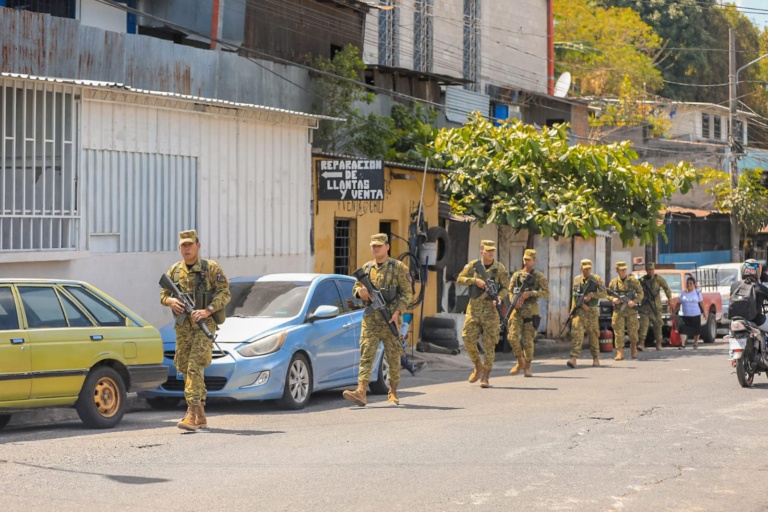
The pro-government deputies approved in early January the tenth extension of martial law that allows the government, among other things, to hide information on public spending. The exception regime includes the suspension of the constitutional guarantees of Salvadorans and the use of the military in public security.
Since March 2022 when El Salvador’s government began implementation of its cornerstone security strategy, it has been marked by reports of human rights violations, arbitrary detentions, abuses by security forces, forced disappearances, and blockades to access to public information by the State.
This is revealed by the latest report from human rights organizations that compiled thousands of complaints of police abuse, torture, persecution and lack of judicial guarantees attributed to the National Civil Police (PNC), the Armed Forces (FAES) and the Prosecutor’s Office (FGR). Despite the mounting evidence of abuses, President Nayib Bukele’s approval levels remain high, and his security actions, which include the emergency regime and the use of the military for public security tasks, also continue to be popular.
Over the last nine months, Cristosal, the UCA Human Rights Institute (IDHUCA), the Women Defenders Network, FESPAD, and the Azul Originario organization received 3,211 complaints of arbitrary detentions. “The state of exception regime has had several stages and types in terms of arrests. In the first, it was possible to observe how in the first months there were massive detentions, and the use of stigmatizing criteria such as people’s place of residence. And of course, since there were no criteria for prior investigation, but only where they resided or the existence of tattoos or an age range or physical appearance–there were many arbitrary detentions,” said Ruth Eleonora López, lawyer for Cristosal.
At the end of last year, Attorney General Rodolfo Delgado announced that the government had arrested more than 60,000 suspected gang members in the context of the “war” launched by Bukele in March 2022 under the exception regime. Human Rights Watch (HRW) also pointed out that many of the arrests were made based on physical appearance and place of residence of the detainees, generally from marginalized areas that have historically been hotspots for violence in the Central American country.
More:
https://www.counterpunch.org/2023/03/17/el-salvador-under-a-state-of-exception-human-rights-violations-and-suspension-of-freedoms/
Amazon Rainforest Destabilizes the World
MARCH 17, 2023
BY ROBERT HUNZIKER

Image by Vlad Hilitanu.
A new 40-year study discovered the eye-opening fact that what happens in the Amazon Rainforest impacts the entire Earth system. This puts an exclamation point on the fact that the Amazon Rainforest, the planet’s most crucial source of life support, is in deep trouble mainly because of massive deforestation.
The Amazon River Basin is the world’s largest rainforest, larger than the next two largest rainforests combined, the Congo Basin and Indonesia, and roughly the size of the forty-eight contiguous United States covering 40% of South America including parts of Brazil, Bolivia, Peru, Ecuador, Colombia, Venezuela, Guyana Suriname and French Guiana.
According to the World Wildlife Fund (WWF): “The Amazon is of vital importance because people around the world, as well as locally, depend on the rainforest. Not just for food, water, wood and medicines, but to help stabilize the climate—around 76 billion tonnes of carbon is stored in the Amazon rainforest., The trees in the Amazon also release 20 billion tonnes of water into the atmosphere per day, playing a critical role in global and regional carbon and water cycles.”
The 40-year study links Amazonian deforestation to reduced Tibetan snows and Antarctic ice loss. Both carry serious consequences, respectively, loss of nature’s water towers for millions of people as sea levels rise everywhere.
More:
https://www.counterpunch.org/2023/03/17/amazon-rainforest-destabilizes-the-world/
Child Labor is Back...with a Vengeance!
MARCH 17, 2023
BY EVE OTTENBERG

Photograph Source: E. F. Brown – Public Domain
Child labor is back. That’s because rich corporations and their political parasites want it back. What better way, they doubtless imagine, for penniless, unaccompanied migrant children to spend their time than performing dangerous tasks in slaughterhouses or moiling with toxic cleansers in factories? What else are these kids going to do with their time? Go to school? Not likely, if our oligarchs have it their way. Corporate billionaires need workers, especially post-Great Resignation, when millions of employees, after remembering thanks to covid that life is short, basically said “You can take this lousy job and shove it.” As a result, it’s a tight labor market, despite the Federal Reserve’s best efforts to boost unemployment, to wit, Fed chairman Jerome Powell’s interest rate increases, his volley in the class war that backfired, potentially taking down the banks (poetic justice that could ruin us all). And a tight labor market means higher wages. Our corporate bigwigs don’t like that at all, and thus eye child workers all the more eagerly, because they can pay them peanuts.
Also jumping on the tawdry child labor bandwagon are states like Minnesota and Iowa. There, GOP legislators want exceptions to child labor regulations, so kids can work longer hours and to “protect employers from liabilities due to sickness or accidents,” per the proposed bills’ language, as RT reported February 24. Washington even lends a hand – with a new rule in January, lowering the age of professional truck drivers from 21 to 18. So now, according to CNN January 19, 18-year-olds can drive semi-trucks across state lines, because “the U.S. government is setting up an apprenticeship program for young truckers.” This will lead to many more collisions and other potentially lethal events, but the feds don’t care – like Powell, they see a class war to win for the billionaires, so road safety? A thing of the past, innit?
If you ask cui bono? The answer isn’t these luckless teenagers. It’s the industry, which needs roughly 80,000 more drivers. Currently 49 states and Washington, D.C. license people under 21 – but not to cross state lines. So this program seems like fixing a mere technicality, right? Wrong. What’s never mentioned is raising truckers’ wages. That would solve the staffing shortage tout de suite. But the American Trucking Association is so shy about mentioning this, it hasn’t murmured a peep, and so our brave government officials, taking their cue from industry’s reticence, tiptoe around it too.
The Truck Safety Coalition has vociferously criticized moves to have kids haul semis across state lines, going back to September 2020, CNN reports. That’s when the Federal Motor Carrier Safety Administration first proposed a pilot program to allow people 18 years and older to do interstate truck driving; but it wasn’t implemented until November 2022. Youthful truckers boast an extremely high accident rate, so you’ll be relieved to know these apprentices won’t be permitted to drive trucks carrying toxic materials, thus decreasing the chances for innumerable mini-East Palestine catastrophes across the country.
More:
https://www.counterpunch.org/2023/03/17/child-labor-is-back-with-a-vengeance/
Teaching Torture: The Death and Legacy of Dan Mitrione
AUGUST 13, 2020
BY BRETT WILKINS

In the pre-dawn darkness of Monday, August 10, 1970, Dan Mitrione’s bullet-ridden body was discovered in the back seat of a stolen Buick convertible in a quiet residential neighborhood of Montevideo, the Uruguayan capital. He had just turned 50, and he had recently started a new dream job, although it was thousands of miles from his home in Richmond, Indiana. Who was Dan Mitrione, and what work was he doing in Uruguay that led him to such an early and violent end?
As the Cold War heated up, one of the ways in which the United States government fought communism abroad was through foreign assistance programs. These were favorite vehicles for Central Intelligence Agency and other US meddling. Dan Mitrione, a Navy veteran and former small-town police chief from Indiana, joined one such agency, the International Cooperation Administration, in 1960. The following year, ICA was absorbed by the United States Agency for International Development, which in addition to its stated mission of administering assistance to developing nations, gained global notoriety for its role in helping brutal dictatorships repress, torture and murder innocent men, women and children around the world.
Brazil Brutality
Mitrione’s first posting was in Belo Horizonte, Brazil, where he worked on the police aid program for USAID’s Office of Public Safety. OPS trained and armed friendly — read anti-communist — Latin American police and security officers. Ostensibly, it was meant to teach police how to be less corrupt and more professional. In practice, it operated as a CIA proxy. As for its parent organization, one former USAID director, John Gilligan, later admitted it was “infiltrated from top to bottom with CIA people.” Gilligan explained that “the idea was to plant operatives in every kind of activity we had overseas; government, volunteer, religious, every kind.”
Before Mitrione’s arrival, standard operating procedure for Brazilian police was to beat a suspect nearly to death; if he talked he lived, if not, well… Under Mitrione’s tutelage, officers introduced refined torture techniques drawn from the pages of KUBARK, a CIA instruction manual describing various physical and psychological methods of breaking a prisoner’s will to resist interrogation. Many of the abuses in KUBARK would later become familiar to the world as the “enhanced interrogation” techniques used during the US war against terrorism: prolonged constraint or exertion, ‘no-touch’ torture (stress positions), extremes of heat, cold or moisture and deprivation or drastic reduction of food or sleep. KUBARK also covers the use of electric shock torture, a favorite tool of both the Brazilian and Uruguayan police under Mitrione’s instruction.
More:
https://www.counterpunch.org/2020/08/13/teaching-torture-the-death-and-legacy-of-dan-mitrione/
Dan Mitrione, Wikipedia:
Daniel Anthony Mitrione (August 4, 1920 – August 10, 1970) was a U.S. government official in Latin America who trained local police in the use of torture[citation needed]. He was kidnapped and murdered by the Tupamaros guerrilla group fighting against the authoritarian government in Montevideo, Uruguay.
In 1969, Mitrione was appointed the OPS Chief Public Safety Adviser in Montevideo, Uruguay. In this period the Uruguayan government, led by the Colorado Party, had its hands full with a collapsing economy, labor and student strikes, and the Tupamaros, a left-wing urban guerrilla group. On the other hand, Washington feared a possible victory during the elections of the Frente Amplio, a left-wing coalition, on the model of the also-Cuban-supported victory of the Unidad Popular government in Chile, led by Salvador Allende, in 1970.[6] The OPS had been helping the local police since 1965, providing them with weapons and training.
Former Uruguayan police officials and CIA operatives[who?] stated Mitrione had taught torture techniques to Uruguayan police in the cellar of his Montevideo home, including the use of electrical shocks delivered to his victims' mouths and genitals.[7] His credo was "The precise pain, in the precise place, in the precise amount, for the desired effect."[8] He also helped train foreign police agents in the United States in the context of the Cold War. In 1978, at the 11th International Youth Festival in Cuba, Manuel Hevia Cosculluela, a Cuban who claimed to have infiltrated the CIA as double agent from 1962 to 1970, stated that Mitrione ordered the abduction of homeless people, so that he could use them as 'guinea pigs' in his torture classes.[9][10][11] He said that attempts would be made to keep each victim alive for multiple torture sessions,[9][11] but that torture would eventually kill them, and that their mutilated bodies would be dumped in the streets. He claimed that Mitrione personally tortured four homeless people to death.[9]
Mitrione's captors may also have believed him to be the inventor of a torture device known as the "Mitrioni vest".[12] This alleged device was described as "an inflatable vest which can be used to increase pressure on the chest during interrogation, sometimes crushing the rib cage."[12]
Mitrione was kidnapped by the Tupamaros on July 31, 1970[13] demanding the release of 150 political prisoners.[14] The Uruguayan government, with U.S. backing, refused and Mitrione was later found dead in a car, shot twice in the head.[15] There were no other visible signs of maltreatment,[16] beyond the fact that during the kidnapping, Mitrione had been shot in one shoulder, a wound that was clean and healing well, and had evidently been treated while in captivity.[16]
. . .
Commemoration
The Nixon Administration, through spokesman Ron Ziegler, affirmed that Mitrione's "devoted service to the cause of peaceful progress in an orderly world will remain as an example for free men everywhere."[19] His funeral was widely publicised by the U.S. media and was attended by, amongst others, David Eisenhower and Richard Nixon's secretary of state William Rogers.
Frank Sinatra and Jerry Lewis held a benefit concert for his family in Richmond, Indiana.[20]
More:
https://en.wikipedia.org/wiki/Dan_Mitrione
NIXON ADMINISTRATION ADVOCATED USE OF DEATH SQUADS IN URUGUAY, NEW DOCUMENTS INDICATE
AUGUST 17, 2010 BY MARI HAYMAN
NEW YORK — Forty years after U.S. AID official Dan Mitrione was kidnapped and executed by Uruguayan guerillas, nine declassified State Department documents prove that high-level officials in the Nixon Administration advocated the use of death threats against Uruguayan guerrillas, political dissidents, and their families.
The Washington-based National Security Archive released the documents last Wednesday on the anniversary of Mitrione’s August 10, 1970 death, when the former U.S. AID official’s body was found shot at close range after ten days in captivity. Mitrione’s death escalated the Uruguayan government’s campaign against the MLN-Tupamaros and other leftist guerilla organizations as well as students, union leaders, and political opposition, eventually leading to the country’s 1973 civil-military coup and twelve years of dictatorship.
According to Carlos Osorio, director of the National Security Archive’s Southern Cone project, “The documents reveal the U.S. went to the edge of ethics in an effort to save Mitrione—an aspect of the case that remained hidden in secret documents for years.”
Mitrione, a former police officer, arrived in Uruguay in 1969 to provide logistical and technical support to the Uruguayan police as director of the U.S Agency for International Development’s Office of Public Safety. Suspecting Mitrione of training security forces to torture detainees during the government’s aggressive counter-insurgency campaign, the Tupamaros kidnapped him on July 31, 1970, and demanded the release of 150 political prisoners in return for his life — a demand that was immediately rebuffed by then-president Jorge Pacheco. Mitrione was found dead ten days later.
More:
https://latindispatch.com/2010/08/17/nixon-administration-advocated-use-of-death-squads-in-uruguay-new-documents-indicate/
URUGUAY: HOW WE CRUSH NONVIOLENT PROTEST AGAINST A CORRUPT REGIME, USING THE SOA TO UNDERMINE OUR O
URUGUAY:
HOW WE CRUSH NONVIOLENT PROTEST AGAINST A CORRUPT REGIME, USING THE SOA TO UNDERMINE OUR OWN LAWS
URUGUAY:
HOW WE CRUSH NONVIOLENT PROTEST AGAINST A CORRUPT REGIME, USING THE SOA TO UNDERMINE OUR OWN LAWS
(1) The Uruguayan military institutes a totalitarian regime far beyond anything in Eastern Europe.
(2) This is done with full US support, including torture-training from the SOA.
During the 1960s, Uruguay is in the midst of a long-running economic decline under the watch of US corporations and a US-supported anti-democratic regime, with widespread poverty, labor strikes, student demonstrations, and militant street violence, and the largely nonviolent Tupamoros, "[p]erhaps the cleverest, most resourceful and most sophisticated urban guerrillas the world had ever seen," with widespread public support and secret admirers in key positions in the government, banks, universities, professions, military, and police.
"[T]he Tupamoros normally avoid bloodshed when possible. They try instead to create embarrassment for the Government and general disorder." � New York Times, 8/1/70 [E.g., publishing raided files of big private corporations to expose corruption and deceit, or publishing transcripts of trials in "People�s Court" of temporarily kidnapped corrupt public officials.]
The US-armed and US-trained military crush the Tupamoros in 1972, institute 11 years of repressive dictatorship, with "the largest number of political prisoners per capita in the world [about 60,000 people, roughly 2 percent of the population], � each one of them was tortured." � The Guardian (London) 10/19/84, Human Rights Quarterly, 5/82.
. . .
People were in prison so that prices could be free."
� dissident Uruguayan writer Eduardo Galeano
The American torture-training role �
"The precise pain, in the precise place, in the precise amount, for the desired effect." � Dan Mitrione, head of the US "Office of Public Safety" in Montevideo, 1969-1970
"The violent methods [of "routine torture"] which were beginning to be employed [by "US advisers, and in particular Mitrione"] caused an escalation in Tupamaro activity. Before then their attitude showed that they would use violence only as a last resort." Alejandro Otero, Uruguayan Chief of Police Intelligence, CIA agent, demoted for his testimony
"One of the pieces of equipment that was found useful was a wire so very thin that it could be fitted into the mouth between the teeth and by pressing the gum increase the electrical charge. And it was through the diplomatic pouch that Mitrione got some of the equipment he needed for interrogations, including these fine wires." � New York Times� A.J. Langguth, 1981 interview
More:
http://www-personal.umich.edu/~lormand/poli/soa/uruguay.htm
Richard Nixon sent a U.S. torture specialist, Dan Mitrione, to Uruguay to help out.....
From the documents at the National Security Archives:
TO SAVE DAN MITRIONE NIXON ADMINISTRATION URGED
DEATH THREATS FOR URUGUAYAN PRISONERS
In Response Uruguayan Security Forces Launched Death Squads to Hunt and Kill Insurgents
National Security Archive Electronic Briefing Book No. 324
By Carlos Osorio and Marianna Enamoneta
With the Collaboration of Clara Aldrighi
Posted – August 11, 2010
For more information contact:
Carlos Osorio: cosorio@gwu.edu, (202) 994-7061
Clara Aldrighi: clara.aldrighi@gmail.com
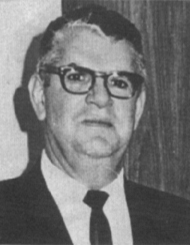
Dan Mitrione
Washington, D.C., August 11, 2010 - Documents posted by the National Security Archive on the 40th anniversary of the death of U.S. advisor Dan Mitrione in Uruguay show the Nixon administration recommended a “threat to kill [detained insurgent] Sendic and other key [leftist insurgent] MLN prisoners if Mitrione is killed.” The secret cable from U.S. Secretary of State William Rogers, made public here for the first time, instructed U.S. Ambassador Charles Adair: “If this has not been considered, you should raise it with the Government of Uruguay at once.”
The message to the Uruguayan government, received by the U.S. Embassy at 11:30 am on August 9, 1970, was an attempt to deter Tupamaro insurgents from killing Mitrione at noon on that day. A few minutes later, Ambassador Adair reported back, in another newly-released cable, that “a threat was made to these prisoners that members of the ‘Escuadrón de la Muerte’ [death squad] would take action against the prisoners’ relatives if Mitrione were killed.”
Dan Mitrione, Director of the U.S. AID Office of Public Safety (OPS) in Uruguay and the main American advisor to the Uruguayan police at the time, had been held for ten days by MLN-Tupamaro insurgents demanding the release of some 150 guerrilla prisoners held by the Uruguayan government. Mitrione was found dead the morning of August 10, 1970, killed by the Tupamaros after their demands were not met.
“The documents reveal the U.S. went to the edge of ethics in an effort to save Mitrione—an aspect of the case that remained hidden in secret documents for years,” said Carlos Osorio, who directs the National Security Archive’s Southern Cone project. “There should be a full declassification to set the record straight on U.S. policy to Uruguay in the 1960’s and 1970’s.”
“In the aftermath of Dan Mitrione’s death, the Uruguayan government unleashed the illegal death squads to hunt and kill insurgents,” said Clara Aldrighi, professor of history at Uruguay’s Universidad de la República, and author of “El Caso Mitrione” (Montevideo: Ediciones Trilce, 2007). “The U.S. documents are irrefutable proof that the death squads were a policy of the Uruguayan government, and will serve as key evidence in the death squads cases open now in Uruguay’s courts,” Osorio added. "It is a shame that the U.S. documents are writing Uruguayan history. There should be declassification in Uruguay as well,” stated Aldrighi, who collaborated in the production of this briefing book.
More:
https://nsarchive2.gwu.edu/NSAEBB/NSAEBB324/index.htm
Profile Information
Member since: 2002Number of posts: 160,656